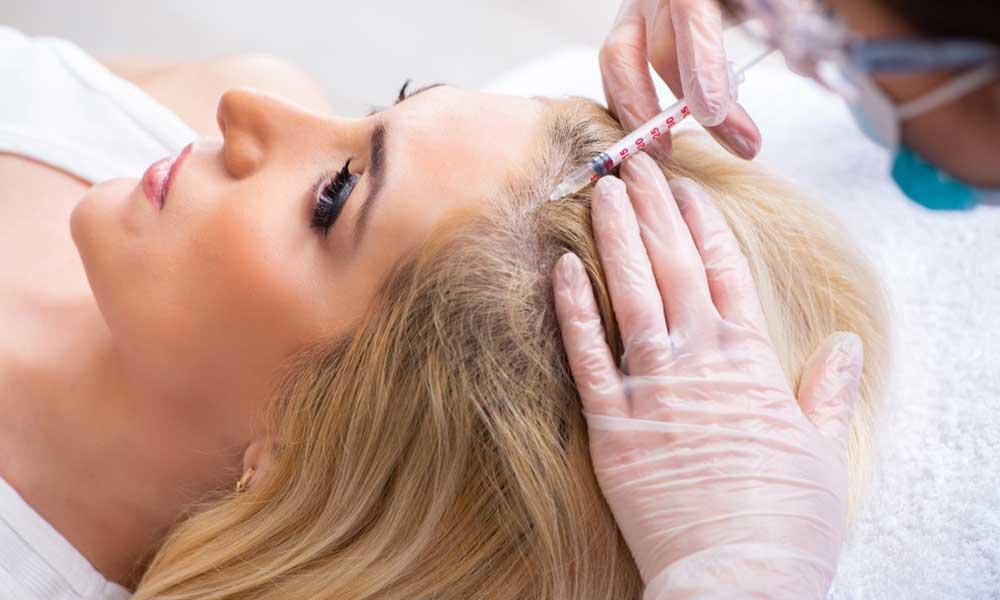📍 1400 N. Coit Road, Suite 302, McKinney, TX 75071 ✉️ info@springcareclinic.com 📞(972) 512-0243
Hair Restoration

What is Hair Restoration?

Hair restoration is a medical and cosmetic procedure aimed at addressing hair loss and promoting hair regrowth. It involves various techniques and treatments to restore hair density, improve hairline aesthetics, and enhance overall hair health. Currently, SpringCare offers hair restoration services with exosomes and/or prescription medications for hair loss.
Types of Hair Restoration
- Exosomes: These are a relatively new and innovative approach in the field of hair restoration. They are tiny vesicles (30-150 nanometers in diameter) secreted by cells that play a crucial role in cell-to-cell communication. Exosomes contain various growth factors, proteins, lipids, and genetic material, which can influence the behavior of surrounding cells and promote healing and regeneration.
In the context of hair restoration, exosomes can:
- Promote Hair Growth: By delivering growth factors and signaling molecules to hair follicles, exosomes can stimulate the proliferation and differentiation of cells in the hair follicle, potentially leading to increased hair growth.
- Reduce Inflammation: Exosomes can have anti-inflammatory effects, which may be beneficial in treating certain types of hair loss that are associated with inflammation, such as alopecia areata.
- Enhance Healing: Exosomes can promote tissue repair and regeneration, which can improve the health and functionality of hair follicles.
Hair Transplant Surgery: This involves transplanting hair follicles from a donor area (typically the back of the head) to the balding or thinning areas. The two main methods are:
- FUT (Follicular Unit Transplantation): A strip of scalp with hair follicles is removed, and individual follicles are then transplanted.
- FUE (Follicular Unit Extraction): Individual hair follicles are extracted directly from the donor area and transplanted.
Platelet-Rich Plasma (PRP) Therapy: PRP is derived from the patient’s blood, which is then injected into the scalp to stimulate hair growth and improve hair density.
Medications: Multiple medications can contribute to effective hair regrowth. Two popular medications that are used for hair restoration include oral/topical Minoxidil and Finasteride.
- Oral Minoxidil: This is a medication used to treat hair loss, primarily in cases of androgenetic alopecia (male and female pattern baldness). Originally developed and approved as a treatment for high blood pressure, minoxidil was found to have a side effect of promoting hair growth. This discovery led to the development of topical minoxidil (Rogaine), which is commonly used for hair loss. More recently, oral minoxidil has gained attention as an alternative or adjunct to topical treatments.
- Topical Minoxidil (Rogaine): A topical treatment that can slow hair loss and promote regrowth in some people.
- Finasteride (Propecia): An oral medication that can reduce hair loss and sometimes stimulate regrowth by inhibiting the hormone responsible for hair thinning.
Low-Level Laser Therapy (LLLT): A non-invasive treatment using laser light to stimulate hair follicles and promote hair growth.
Scalp Micropigmentation (SMP): A cosmetic procedure that involves tattooing tiny dots on the scalp to create the appearance of fuller hair.
Types of Hair Loss Benefiting from Hair Restoration
- Androgenetic Alopecia (Male and Female Pattern Baldness): The most common form of hair loss, characterized by progressive thinning of the hair on the scalp.
- Alopecia Areata: An autoimmune condition where the immune system attacks hair follicles, causing hair loss in patches.
- Telogen Effluvium: Temporary hair thinning over the scalp that occurs because of changes in the growth cycle of hair.
- Traction Alopecia: Hair loss caused by prolonged tension on the hair, often due to hairstyles like braids or ponytails.
- Scarring Alopecia: Hair loss resulting from inflammation that leads to scarring of the hair follicles, which can be caused by conditions such as lichen planopilaris or lupus.
- Hair Loss Due to Medical Treatments: Such as chemotherapy or radiation therapy.
Each type of hair restoration treatment has its specific applications, suitability, and effectiveness based on the underlying cause and extent of hair loss. Our consultation process will determine the best fit for your needs.
Frequently Asked Questions

We specialize in:
✅ Exosome Therapy – Stimulates follicles using growth-rich stem cell proteins
✅ FDA-approved medications – including topical/oral solutions to slow hair loss
Most patients notice:
3–6 months: Visible thickening and reduced shedding
Full results: Typically after 12 months (varies by treatment)
Tip: We provide progress photos at each follow-up visit.
Our minimally invasive treatments involve:
💉 Brief discomfort (similar to a pinprick) during injections
❄️ Topical numbing to ensure comfort
⏱️ No downtime – Resume daily activities immediately
Ideal for:
Men/women with thinning hair or receding hairlines
Patients with pattern baldness (androgenetic alopecia)
Those seeking non-surgical solutions
Note: We assess eligibility during a free consultation.
Costs depend on:
Treatment type (exosome vs. medications)
Area size (scalp coverage needed)
Package discounts for multiple sessions
💳 Flexible financing via Cherry available
Patient Stories
Testimonials
Trustindex verifies that the original source of the review is Google. Excellent facility, I had the opportunity to visit this clinic. Dr. Phyllis was very nice, friendly, and very professional. Most important she knows her stuff. I would recommend her to anyone I know. Thank you Dr. PhyllisTrustindex verifies that the original source of the review is Google. Words alone can’t capture how incredible my experience was with this place, the doctor, and the staff. They are truly exceptional—prompt, professional, and genuinely caring about your well-being. This is exactly where you want to be when you need care.Trustindex verifies that the original source of the review is Google. Always easy to book appointment. Quick responses and I love they offer virtual visits. Dr. Phyllis listens and provides great explanations on her diagnosis.Trustindex verifies that the original source of the review is Google. I love this clinic. Dr. Onyedubelu is super attentive, helpful and friendly. Everything of concern was addressed, I felt heard and supportive. I can?t wait to see my results. Thank you Spring Care Clinic, for addressing all my health needs.Trustindex verifies that the original source of the review is Google. I have been a patient of Dr. Uzoamaka Onyedebelu for several months now. The amazing care that I have received since being a patient of hers has been beyond impeccable. The patience, empathy and compassion that she has shown me is certainly unmatched and the epitome of quality healthcare. I would highly recommend her services to everyone I know.Trustindex verifies that the original source of the review is Google. I had a visit with Uzoamaka Onyedebelu, needing some medication. She prescribed some meds that cost more than $1000. (just to get some commissions). messaged her multiple times to change them to a generic form, never responded. She cares about money not you. Just find an MD, not a NP like her.Trustindex verifies that the original source of the review is Google. Satisfied with care and treatment!Trustindex verifies that the original source of the review is Google. Always fast to communicate effectively and have help me so far in my journey
Your Health, On Your Schedule
Online Appointments and Prescriptions

Book virtual or in-person visits in minutes—no waiting on hold. Our secure platform lets you:
✓ Schedule same-day telehealth consults
✓ Request prescription refills online
✓ Get personalized care from home
Your Health, On Your Schedule
Online Appointments and Prescriptions

Book virtual or in-person visits in minutes—no waiting on hold. Our secure platform lets you:
✓ Schedule same-day telehealth consults
✓ Request prescription refills online
✓ Get personalized care from home
SpringCare
Clinic
- 1400 N. Coit Road, Suite 302, McKinney, TX 75071
- 5373 W Alabama St #204 Houston, TX 77056
- (972) 512-0243
- info@springcareclinic.com
Quick links
Useful links
Subscribe for Updates
To get the latest news about health from our experts

